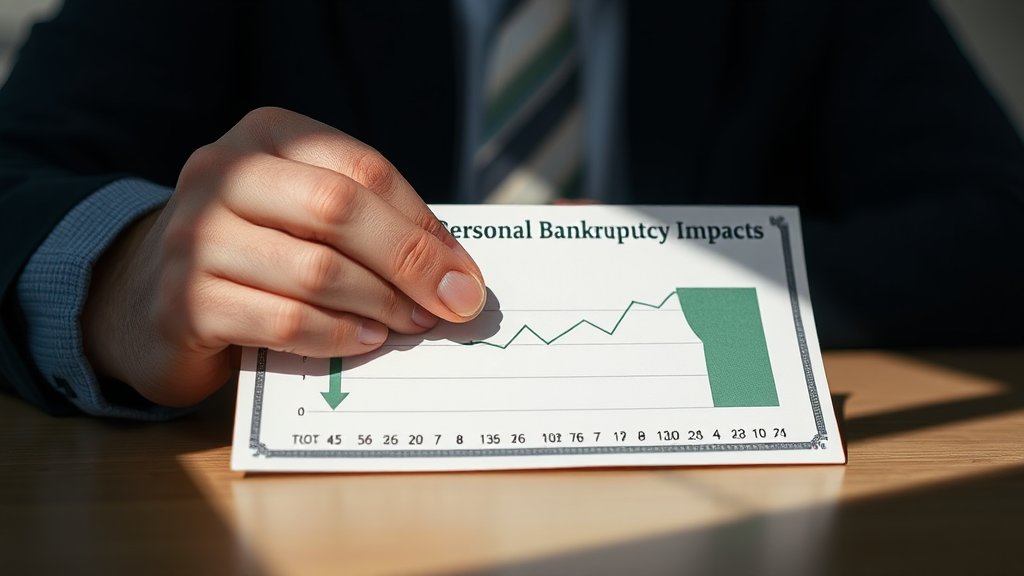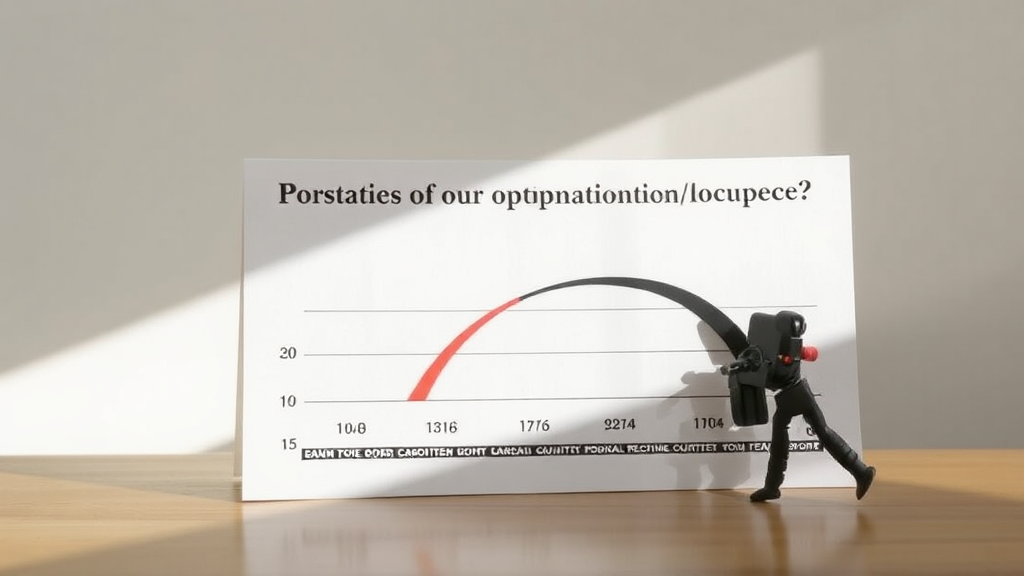Bankruptcy: Credit Score Impact
What it Does to the Report
bankruptcy, credit score
Filing for personal bankruptcy severely lowers your credit score and stays on your report for six to seven years. Securing new credit will be tough, often with high interest rates. To rebuild, use secured credit cards, pay bills on time, and keep balances low. Seek advice from licensed insolvency trustees and use available resources for support.

Article: Personal Bankruptcy Impact on Credit Score
Immediate Impact on Credit Score
Filing for personal bankruptcy drops your credit score to the lowest rating., Bankruptcy is recorded on your credit report for six years after discharge or seven years if you have been bankrupt before., Most lenders will consider you a high-risk borrower.
Filing for personal bankruptcy can be a tough decision, but it's important to understand its immediate impact on your credit score in Canada. When you file for bankruptcy, your credit score plummets to the lowest rating possible. This isn't a small dip—it's a significant drop that stays with you for quite some time. Bankruptcy serves as a red flag to potential lenders, signaling serious financial distress and affecting your ability to secure loans or credit in the near future.
To make matters more lasting, bankruptcy remains on your credit report for six years after discharge, or even seven years if you’ve been bankrupt before. This extended period can feel like a long time when you’re trying to rebuild your financial life. For example, if you filed for bankruptcy in 2023 and were discharged within the same year, this mark won’t disappear from your credit report until 2030, making it harder to get favorable loan terms or even rent an apartment during that time. It’s crucial to use this period wisely to rebuild your credit and prove to lenders that you’re a responsible borrower.
Because of this enduring mark on your credit report, most lenders will consider you a high-risk borrower. This doesn’t mean you’ll never get credit again, but it does mean you’ll face higher interest rates and may need to provide more collateral to secure a loan. Imagine trying to buy a car or secure a mortgage; with a bankruptcy on your record, the terms will likely be far from ideal. However, as you demonstrate improved financial behavior—such as paying bills on time and managing new credit responsibly—you can slowly regain lenders’ trust and improve your credit score over time.
Long-Term Effects on Creditworthiness
Difficulty in obtaining new credit or loans post-bankruptcy., High interest rates on new credit products due to perceived risk., Some insurance companies may view bankruptcy negatively, impacting premiums.
Facing bankruptcy can feel like trudging through a financial storm, and one of the long-term effects is the difficulty in obtaining new credit or loans. Imagine trying to buy a new car or securing a mortgage after declaring bankruptcy—lenders see a high-risk borrower and may deny applications outright. Even if you do get approved, expect limited options and higher-down payment requirements. This credit drought can make it feel like you're constantly hitting roadblocks just when you need a fresh start.
High-interest rates are another hurdle to watch out for. Post-bankruptcy, lenders often perceive you as a financial risk, which usually means you’ll be offered credit products with sky-high interest rates. Think of it like this: while someone with a good credit score might get a credit card with a 15% interest rate, you could be looking at 25% or more. This makes everyday expenses and any debt much more expensive to manage, and it feels like you’re being punished just for trying to bounce back.
Bankruptcy can also leave a mark on your insurance premiums. Some insurance companies view bankruptcy as a red flag, interpreting it as a sign of financial instability. This risk perception can lead to higher premiums on everything from home to auto insurance. For example, if you’ve recently filed for bankruptcy, you might find your car insurance renewal quotes are suddenly higher than what you paid before. It’s frustrating but knowing in advance allows you to shop around and find the best deals, ensuring you’re not paying more than necessary.
Elimiate up to 80% of Your Debt
High cost of gas, high cost of groceries, high lending rates, low salary - being in debt is not your fault! See if you qualify for government debt programs and get out of debt today!
Rebuilding Credit Post-Bankruptcy
Secured credit cards as a tool for rebuilding credit., Timely bill payments and maintaining low balances can improve credit over time., Enrolling in a credit monitoring service can help track progress.
Secured credit cards can play a crucial role in rebuilding credit after bankruptcy in Canada. Think of a secured credit card as training wheels for your financial bicycle; it gives you the chance to practice managing credit responsibly without the full risk. Essentially, you deposit an amount of money with the issuing bank, and that sum becomes your credit limit. As you use this card for small purchases and pay off the balance on time every month, your responsible behavior gets reported to the credit bureaus. Over time, this can positively influence your credit score. For instance, depositing $500 and using the card for monthly groceries can be a smart way to start.
Timely bill payments and maintaining low balances can significantly improve your credit over time. It’s like watering a plant consistently; the steady care will yield results eventually. Post-bankruptcy, it’s essential to show creditors that you are reliable. By paying off your secured credit card balance each month, you avoid high-interest charges and demonstrate fiscal responsibility. Likewise, keeping a low balance—using less than 30% of your available credit—can further enhance your credit score. Consider setting up reminders or automatic payments to ensure you never miss a due date. Remember, each timely payment is a step towards a healthier credit profile.
Enrolling in a credit monitoring service is another practical step. Imagine it as having a fitness tracker for your financial health; it keeps you informed of your progress and alerts you to any setbacks. These services allow you to regularly check your credit report for accuracy, track credit score changes, and detect any fraudulent activities early. By closely observing your financial habits and outcomes, you can make informed decisions to improve your credit standing. Many services also provide personalized tips for credit improvement, making it easier to spot areas that need attention. A service like Borrowell or Credit Karma can be an effective way to stay on top of your credit rebuilding journey.

Understanding bankruptcy’s effects on your credit score
Employment and Housing Considerations
Some employers may view bankruptcy unfavorably, particularly in finance-related positions., Landlords may require a guarantor or a larger deposit when renting to someone with a bankruptcy history., Providing explanations and proof of financial stability can mitigate concerns.
Navigating employment after filing for bankruptcy can be a bit of a rollercoaster, especially in finance-related positions. Employers in these fields might view your bankruptcy history unfavorably, assuming it reflects poorly on your ability to manage financial matters. For instance, if you’re applying for a role as a financial analyst, your bankruptcy might raise some red flags. However, changes in employment laws in Canada prevent discrimination solely based on bankruptcy, so it's all about how you present your situation. Highlight your turnaround story and focus on what you’ve learned from the experience—it can show resilience and a keen understanding of financial recovery.
Finding housing post-bankruptcy isn’t a walk in the park either. Many landlords are cautious when renting to someone with a bankruptcy history, often requiring a guarantor or a larger deposit. Imagine you’re trying to rent in Vancouver—landlords in such rental hotspots might be particularly stringent. To balance the scales, prepare a robust rental application with references and proof of stable income. Offering a larger deposit upfront or suggesting rent payment via direct debit can further assure landlords of your commitment and reliability.
Finally, transparency is your best ally. Whether dealing with potential employers or landlords, providing clear explanations and evidence of your financial stability is crucial. Let’s say you’ve rebuilt your credit score and have a steady job; showcasing these improvements can significantly alleviate their concerns. Create a compelling narrative around your bankruptcy, emphasizing the proactive steps you’ve taken since then. This approach not only builds trust but also demonstrates your dedication to maintaining financial responsibility, turning a potential drawback into an opportunity for growth.
Expert Advice and Resources
Consultations with licensed insolvency trustees for personalized strategies., Financial literacy programs can provide education on managing finances., Government resources and consumer protection agencies can offer guidance and support.
Booking a consultation with a licensed insolvency trustee in Canada can be a game-changer for anyone facing debt challenges. These professionals offer personalized strategies tailored to your specific financial situation, helping you navigate everything from debt repayment plans to potential bankruptcy. For example, if you’re juggling multiple high-interest credit cards, a trustee can advise on consolidating this debt into a single, more manageable monthly payment. This individualized advice can provide a clear pathway to financial stability, relieving a lot of the stress that comes with managing debt on your own.
Financial literacy programs are another invaluable resource for Canadians looking to regain control over their finances. These programs educate you on the fundamentals of budgeting, saving, and investing, making financial planning less of a daunting task. Imagine attending a workshop where experts break down how to create an emergency fund or set realistic financial goals—it’s like getting a cheat sheet for managing money! The more you understand about your finances, the more equipped you’ll be to make decisions that positively impact your financial health long-term.
Government resources and consumer protection agencies in Canada are also here to support you through your financial journey. Agencies like the Financial Consumer Agency of Canada offer a wealth of information on everything from understanding credit scores to recognizing and avoiding scams. They can provide guidelines to help you manage debt and know your consumer rights. Many of these resources are free and easily accessible online, providing you with the tools and knowledge you need to protect yourself and make informed decisions. Don’t underestimate the power of leveraging these resources—they’re designed to help you succeed.
References
| Title, Source |
|---|
| Understanding Your Credit Report and Credit Score, Financial Consumer Agency of Canada (FCAC) |
| How Long Will a Bankruptcy Stay on My Credit Report?, Equifax Canada |
| Improving Your Credit Score, Government of Canada |
| Bankruptcy and Its Effect on Your Credit Rating, Office of the Superintendent of Bankruptcy Canada |
| Managing Debt: Advice for Canadians, Licensed Insolvency Trustees of Canada |
This article references information from the above sources.
Eliminate up to 80% of Your Debt
High cost of gas, high cost of groceries, high lending rates, low salary - being in debt is not your fault! See if you qualify for government debt programs and get out of debt today!